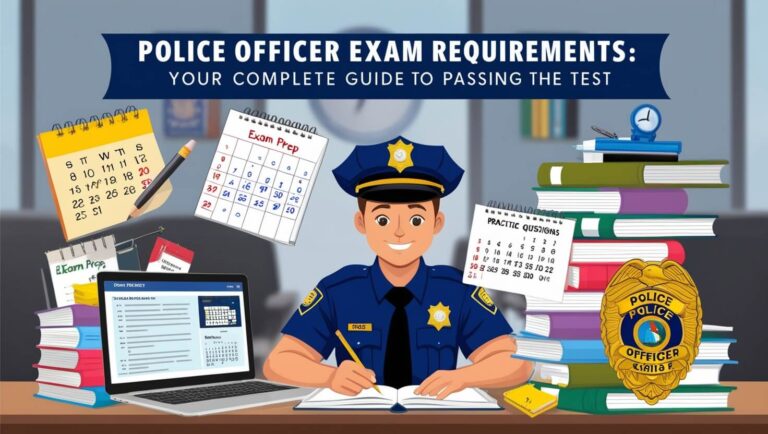What is a Lateral Police Officer: A Comprehensive Guide

Lateral police officers switch between departments, bringing their experience to new places. They help police forces across America by sharing what they’ve learned. These seasoned cops take on key roles in their new teams. Their move affects how police work gets done in different areas. Let’s talk about what lateral officers do and why they matter.
Definition and Overview of Lateral Police Officers
Lateral police officers are seasoned professionals who choose to switch departments, often for personal growth, career advancement, or lifestyle changes. They differ from rookie officers in several key ways:
Key Characteristics of Lateral Police Officers
- Proven track record in law enforcement
- Existing certifications and training
- Familiarity with policing procedures and protocols
- Ability to adapt to new environments quickly
Differences Between Lateral Officers and New Recruits
Lateral officers bring a wealth of experience that sets them apart from fresh academy graduates. While new recruits learn the ropes, lateral hires hit the ground running:
- Reduced training time
- Immediate contribution to patrol duties
- Mentorship capabilities for younger officers
- Diverse problem-solving skills from previous roles
The Role and Responsibilities of Lateral Police Officers
Lateral police officers take on a wide range of duties in their new departments, often with added responsibilities due to their experience.
Core Duties in Law Enforcement
- Enforcing local, state, and federal laws
- Responding to emergency calls
- Conducting traffic stops and issuing citations
- Investigating crimes and collecting evidence
- Writing detailed reports on incidents and arrests
Specialized Tasks for Experienced Officers
Many lateral officers leverage their prior experience to take on more complex assignments:
- Leading specialized units (e.g., SWAT, K-9, narcotics)
- Training new recruits and fellow officers
- Developing community policing strategies
- Assisting with inter-agency operations
Community Engagement and Policing
Lateral officers often excel in community relations, bringing fresh perspectives on:
- Building trust with local residents
- Implementing crime prevention programs
- Engaging with youth through outreach initiatives
- Addressing community concerns at public meetings
Benefits of Lateral Entry Programs for Police Departments
Police departments across the country are recognizing the value of lateral entry programs. These initiatives offer numerous advantages:
Expanding the Talent Pool
Lateral hiring allows departments to:
- Attract skilled officers from other regions
- Diversify their workforce with varied experiences
- Fill specialized positions quickly
Cost-Effectiveness in Training and Onboarding
Bringing in lateral officers can lead to significant savings:
- Reduced academy training costs
- Shorter field training periods
- Lower risk of early career burnout or turnover
Bringing Diverse Experience to the Force
Lateral hires contribute unique perspectives:
- Cross-pollination of best practices from other agencies
- Innovative approaches to long-standing challenges
- Enhanced problem-solving capabilities within the department
The Lateral Transfer Process for Police Officers
Becoming a lateral police officer involves a specific process designed to ensure a good fit for both the officer and the new department.
Eligibility Requirements for Lateral Transfers
Typical prerequisites include:
- Current or recent employment as a sworn officer
- Minimum years of full-time patrol experience (often 2-3 years)
- Valid peace officer certification or license
- Clean disciplinary record
- Meeting physical fitness standards
Application and Screening Procedures
The hiring process for lateral officers usually involves:
- Submitting an application and resume
- Background checks and reference verification
- Physical agility tests
- Psychological evaluations
- Oral interviews with command staff
- Polygraph examinations (in some jurisdictions)
Training and Integration for Lateral Hires
Once hired, lateral officers undergo:
- Abbreviated academy training focusing on local laws and procedures
- Field training to familiarize with the new jurisdiction
- Department-specific policy and technology orientations
Challenges Faced by Lateral Police Officers
While lateral transfers offer many benefits, they also come with unique challenges.
Adapting to New Department Cultures
Lateral officers must navigate:
- Different organizational structures
- Varying policing philosophies
- New standard operating procedures
- Unfamiliar local laws and ordinances
Overcoming Resistance from Existing Staff
Some challenges in integration include:
- Skepticism from long-time department members
- Proving oneself despite prior experience
- Navigating internal politics and established relationships
Balancing Prior Experience with New Protocols
Lateral officers often struggle with:
- Unlearning old habits that don’t align with new policies
- Adapting to different equipment or technology
- Adjusting to new command structures and reporting procedures
Career Advancement Opportunities for Lateral Police Officers
Lateral transfers can open doors to new career paths and growth opportunities.
Specialized Units and Promotions
Experienced officers may find faster tracks to:
- Detective divisions
- Special operations teams
- Supervisory roles (e.g., sergeant, lieutenant)
Leadership Roles for Experienced Officers
Lateral hires often bring leadership skills that can lead to:
- Field training officer positions
- Community liaison roles
- Policy development and implementation tasks
Continuing Education and Professional Development
Many departments offer lateral officers:
- Advanced training programs
- Tuition reimbursement for relevant degrees
- Opportunities to attend specialized law enforcement conferences
The Impact of Lateral Police Officers on Law Enforcement
Lateral police officers significantly influence the departments they join and the communities they serve.
Enhancing Departmental Effectiveness
These experienced officers contribute by:
- Sharing best practices from previous agencies
- Improving efficiency in daily operations
- Bringing fresh ideas to solve long-standing issues
Improving Community Relations
Lateral officers often excel in:
- Implementing successful community policing strategies
- Building bridges between law enforcement and diverse populations
- Introducing innovative outreach programs
Addressing Staffing Shortages in Police Departments
Lateral hiring helps departments:
- Fill vacancies quickly with qualified personnel
- Maintain service levels during recruitment challenges
- Create a more balanced mix of experience levels within the force
Pros and Cons of Becoming a Lateral Police Officer
Officers considering a lateral move should weigh the advantages and potential drawbacks.
Advantages of Lateral Transfers for Individual Officers
Benefits include:
- Opportunities for career growth and new challenges
- Potential for higher salaries or better benefits
- Chance to work in a preferred location or community
- Exposure to different policing styles and technologies
Potential Drawbacks and Considerations
Challenges to consider:
- Possible loss of seniority or rank
- Adjustment period in a new community and department
- Stress on family if relocation is required
- Need to prove oneself again in a new environment
How to Prepare for a Lateral Transfer in Law Enforcement
Officers interested in making a lateral move can take steps to increase their chances of success.
Building a Competitive Profile
To stand out, officers should:
- Maintain an excellent service record
- Seek additional certifications and training
- Develop strong communication and leadership skills
- Stay physically fit and mentally prepared
Researching Potential Departments
Before applying, officers should:
- Study the department’s mission and values
- Understand the community demographics and challenges
- Review the agency’s policies and procedures
- Connect with current officers for insider perspectives
Navigating the Application and Interview Process
Success in lateral hiring often depends on:
- Tailoring resumes to highlight relevant experience
- Preparing for scenario-based interview questions
- Demonstrating knowledge of the new jurisdiction
- Showing enthusiasm for the department’s goals and initiatives
The Future of Lateral Entry in Policing
The landscape of lateral police officer hiring continues to evolve.
Trends in Lateral Hiring Practices
Emerging trends include:
- Increased focus on diversity in lateral recruitment
- Use of social media and digital platforms for outreach
- Virtual hiring processes and remote interviews
- Emphasis on emotional intelligence and community engagement skills
Potential Changes in Policies and Regulations
Future developments may include:
- Standardization of lateral entry requirements across states
- Enhanced reciprocity for certifications and training
- Greater emphasis on continuous learning and adaptability
- Integration of technology skills in lateral officer assessments
The Role of Lateral Officers in Shaping Modern Policing
Lateral police officers are poised to:
- Drive innovation in law enforcement practices
- Contribute to police reform efforts
- Enhance cross-agency collaboration and information sharing
- Promote a culture of continuous improvement in policing
Conclusion
Lateral police officers bring a unique blend of experience, skills, and fresh perspectives to law enforcement agencies. Their contributions enhance departmental effectiveness, improve community relations, and help address staffing challenges. As policing continues to evolve, the role of lateral officers in shaping modern law enforcement practices becomes increasingly significant.
For departments, lateral hiring programs offer a way to quickly bolster their ranks with seasoned professionals. For officers, lateral transfers present opportunities for growth, new challenges, and the chance to make a meaningful impact in different communities.
As we look to the future of policing, lateral police officers will undoubtedly play a crucial role in driving positive change, fostering innovation, and building stronger, more effective law enforcement agencies across the nation.






